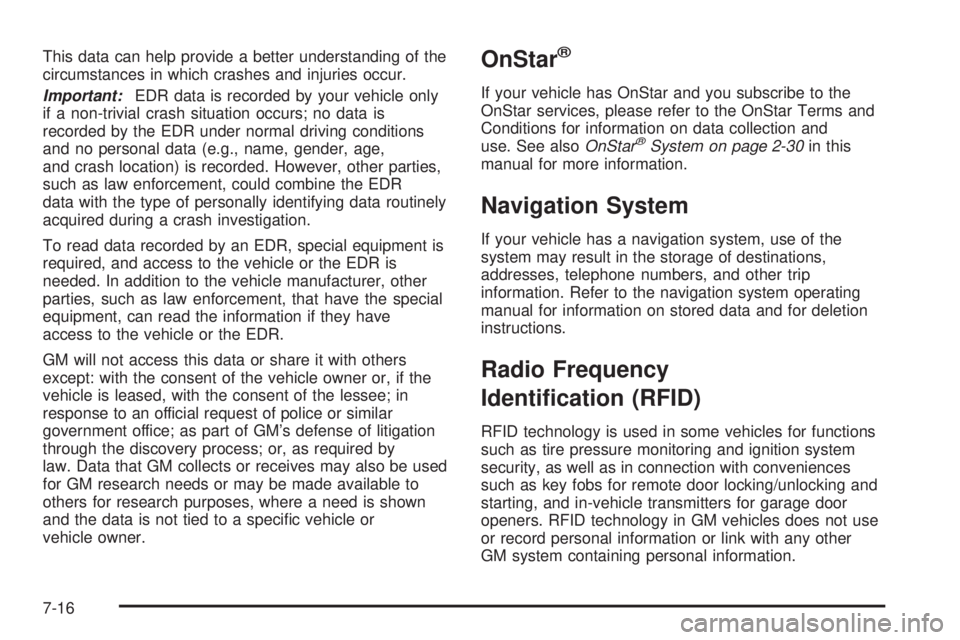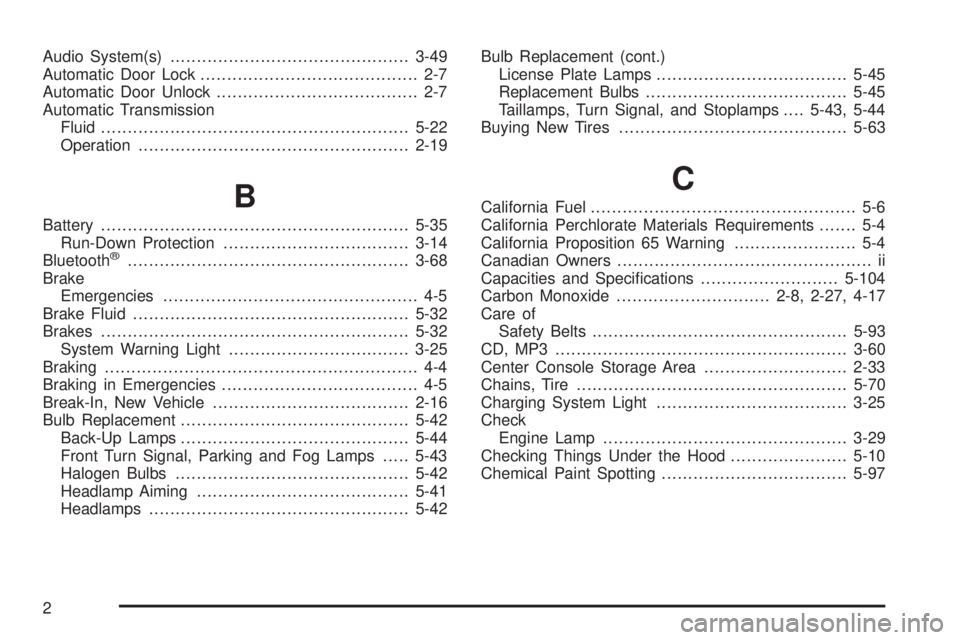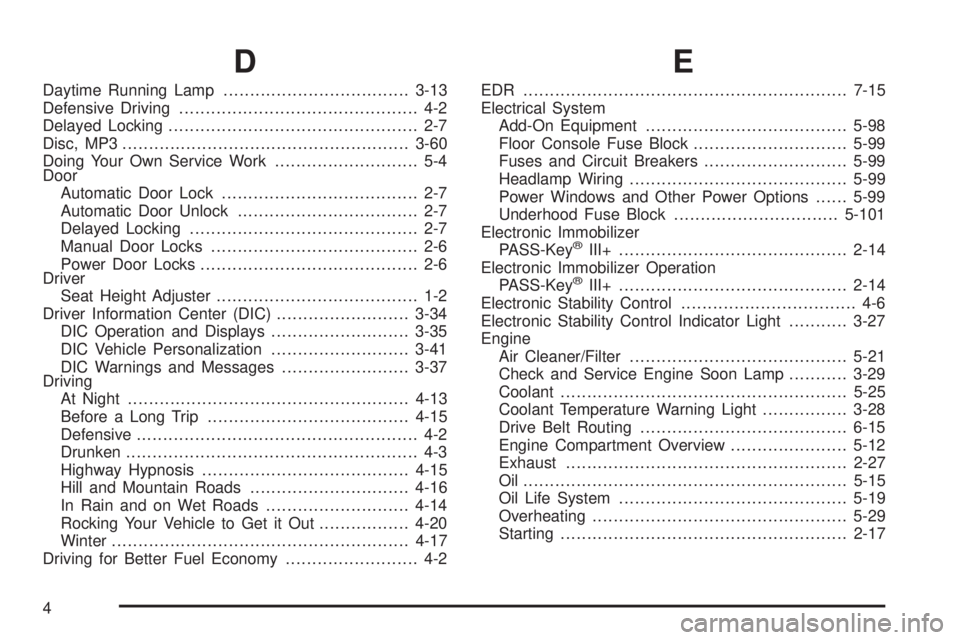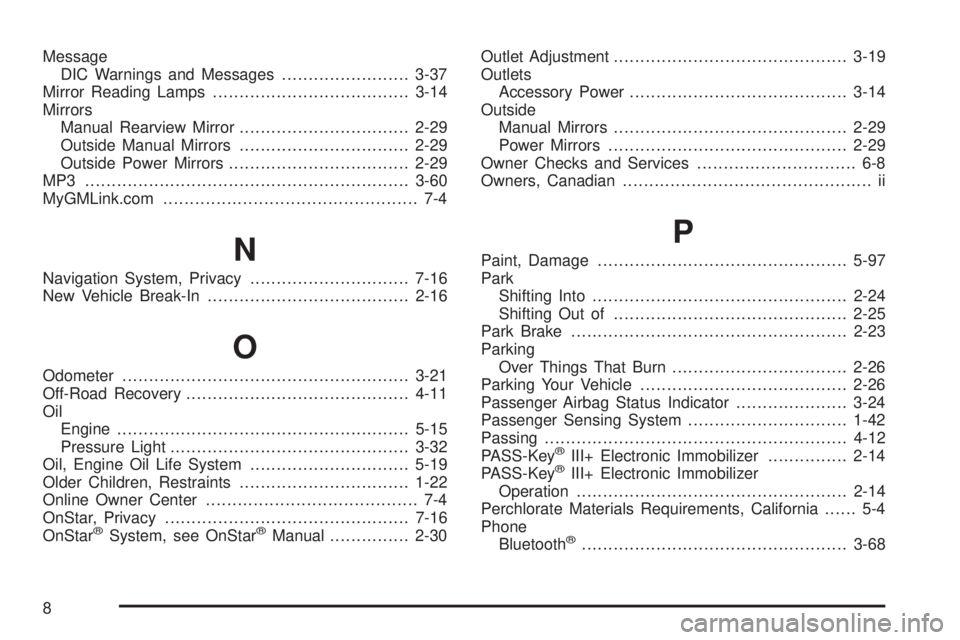PONTIAC SOLSTICE 2009 Owners Manual
Manufacturer: PONTIAC, Model Year: 2009, Model line: SOLSTICE, Model: PONTIAC SOLSTICE 2009Pages: 354, PDF Size: 1.98 MB
Page 341 of 354

ORDER TOLL FREE: 1-800-551-4123
Monday-Friday 8:00 AM - 6:00 PM
Eastern Time
For Credit Card Orders Only
(VISA-MasterCard-Discover), visit Helm, Inc. on the
World Wide Web at: helminc.com
Or you can write to:
Helm, Incorporated
P.O. Box 07130
Detroit, MI 48207
Prices are subject to change without notice and without
incurring obligation. Allow ample time for delivery.
Note to Canadian Customers: All listed prices are
quoted in U.S. funds. Canadian residents are to make
checks payable in U.S. funds.
Vehicle Data Recording and
Privacy
Your GM vehicle has a number of sophisticated
computers that record information about the vehicle’s
performance and how it is driven. For example,
your vehicle uses computer modules to monitor and
control engine and transmission performance, to monitor
the conditions for airbag deployment and deploy
airbags in a crash and, if so equipped, to provideantilock braking to help the driver control the vehicle.
These modules may store data to help your dealer/
retailer technician service your vehicle. Some modules
may also store data about how you operate the
vehicle, such as rate of fuel consumption or average
speed. These modules may also retain the owner’s
personal preferences, such as radio pre-sets, seat
positions, and temperature settings.
Event Data Recorders
This vehicle has an Event Data Recorder (EDR). The
main purpose of an EDR is to record, in certain crash or
near crash-like situations, such as an airbag deployment
or hitting a road obstacle, data that will assist in
understanding how a vehicle’s systems performed. The
EDR is designed to record data related to vehicle
dynamics and safety systems for a short period of time,
typically 30 seconds or less. The EDR in this vehicle
is designed to record such data as:
How various systems in your vehicle were operating
Whether or not the driver and passenger safety
belts were buckled/fastened
How far, if at all, the driver was pressing the
accelerator and/or brake pedal
How fast the vehicle was traveling
7-15
Page 342 of 354

This data can help provide a better understanding of the
circumstances in which crashes and injuries occur.
Important:EDR data is recorded by your vehicle only
if a non-trivial crash situation occurs; no data is
recorded by the EDR under normal driving conditions
and no personal data (e.g., name, gender, age,
and crash location) is recorded. However, other parties,
such as law enforcement, could combine the EDR
data with the type of personally identifying data routinely
acquired during a crash investigation.
To read data recorded by an EDR, special equipment is
required, and access to the vehicle or the EDR is
needed. In addition to the vehicle manufacturer, other
parties, such as law enforcement, that have the special
equipment, can read the information if they have
access to the vehicle or the EDR.
GM will not access this data or share it with others
except: with the consent of the vehicle owner or, if the
vehicle is leased, with the consent of the lessee; in
response to an official request of police or similar
government office; as part of GM’s defense of litigation
through the discovery process; or, as required by
law. Data that GM collects or receives may also be used
for GM research needs or may be made available to
others for research purposes, where a need is shown
and the data is not tied to a speci�c vehicle or
vehicle owner.OnStar®
If your vehicle has OnStar and you subscribe to the
OnStar services, please refer to the OnStar Terms and
Conditions for information on data collection and
use. See alsoOnStar
®System on page 2-30in this
manual for more information.
Navigation System
If your vehicle has a navigation system, use of the
system may result in the storage of destinations,
addresses, telephone numbers, and other trip
information. Refer to the navigation system operating
manual for information on stored data and for deletion
instructions.
Radio Frequency
Identi�cation (RFID)
RFID technology is used in some vehicles for functions
such as tire pressure monitoring and ignition system
security, as well as in connection with conveniences
such as key fobs for remote door locking/unlocking and
starting, and in-vehicle transmitters for garage door
openers. RFID technology in GM vehicles does not use
or record personal information or link with any other
GM system containing personal information.
7-16
Page 343 of 354

A
Accessories and Modi�cations............................ 5-3
Accessory Power Outlets.................................3-14
Adding Equipment to Your Airbag-Equipped
Vehicle.......................................................1-47
Additives, Fuel................................................. 5-6
Add-On Electrical Equipment............................5-98
Air Cleaner/Filter, Engine.................................5-21
Air Conditioning..............................................3-16
Airbag
Passenger Status Indicator...........................3-24
Readiness Light..........................................3-23
Airbag System................................................1-36
Adding Equipment to Your Airbag-Equipped
Vehicle...................................................1-47
How Does an Airbag Restrain?......................1-40
Passenger Sensing System...........................1-42
Servicing Your Airbag-Equipped Vehicle..........1-46
What Makes an Airbag In�ate?......................1-40
What Will You See After an Airbag In�ates?....1-40
When Should an Airbag In�ate?....................1-39
Where Are the Airbags?...............................1-38
Antenna, Fixed Mast.......................................3-81
Antenna, XM™ Satellite Radio Antenna
System......................................................3-81
Antilock Brake System (ABS)............................. 4-4
Antilock Brake, System Warning Light................3-26Appearance Care
Aluminum or Chrome-Plated Wheels..............5-96
Care of Safety Belts....................................5-93
Chemical Paint Spotting...............................5-97
Cleaning Exterior Lamps/Lenses....................5-94
Convertible Top...........................................5-95
Fabric/Carpet..............................................5-91
Finish Care.................................................5-94
Finish Damage............................................5-97
Instrument Panel, Vinyl, and Other Plastic
Surfaces.................................................5-92
Interior Cleaning..........................................5-90
Leather......................................................
5-92
Sheet Metal Damage...................................5-97
Tires..........................................................5-96
Underbody Maintenance...............................5-97
Washing Your Vehicle...................................5-93
Weatherstrips..............................................5-93
Windshield and Wiper Blades........................5-95
Appointments, Scheduling Service....................... 7-8
Ashtray.........................................................3-15
Audio System.................................................3-46
Audio Steering Wheel Controls......................3-79
Chime Level Adjustment...............................3-81
Fixed Mast Antenna.....................................3-81
Radio Reception..........................................3-80
Setting the Clock.........................................3-47
Theft-Deterrent Feature................................3-78
XM™ Satellite Radio Antenna System............3-81
1
Page 344 of 354

Audio System(s).............................................3-49
Automatic Door Lock......................................... 2-7
Automatic Door Unlock...................................... 2-7
Automatic Transmission
Fluid..........................................................5-22
Operation...................................................2-19
B
Battery..........................................................5-35
Run-Down Protection...................................3-14
Bluetooth
®.....................................................3-68
Brake
Emergencies................................................ 4-5
Brake Fluid....................................................5-32
Brakes..........................................................5-32
System Warning Light..................................3-25
Braking........................................................... 4-4
Braking in Emergencies..................................... 4-5
Break-In, New Vehicle.....................................2-16
Bulb Replacement...........................................5-42
Back-Up Lamps...........................................5-44
Front Turn Signal, Parking and Fog Lamps.....5-43
Halogen Bulbs............................................5-42
Headlamp Aiming........................................5-41
Headlamps.................................................5-42Bulb Replacement (cont.)
License Plate Lamps....................................5-45
Replacement Bulbs......................................5-45
Taillamps, Turn Signal, and Stoplamps....5-43, 5-44
Buying New Tires...........................................5-63
C
California Fuel.................................................. 5-6
California Perchlorate Materials Requirements....... 5-4
California Proposition 65 Warning....................... 5-4
Canadian Owners................................................ ii
Capacities and Speci�cations..........................5-104
Carbon Monoxide.............................2-8, 2-27, 4-17
Care of
Safety Belts................................................5-93
CD, MP3 .......................................................3-60
Center Console Storage Area...........................2-33
Chains, Tire...................................................5-70
Charging System Light....................................3-25
Check
Engine Lamp..............................................3-29
Checking Things Under the Hood......................5-10
Chemical Paint Spotting...................................5-97
2
Page 345 of 354

Child Restraints
Child Restraint Systems...............................1-29
Infants and Young Children...........................1-25
Lower Anchors and Tethers for Children..........1-31
Older Children.............................................1-22
Securing a Child Restraint in the Right Front
Seat Position...........................................1-32
Chime Level Adjustment..................................3-81
Cigarette Lighter.............................................3-15
Cleaning
Aluminum or Chrome-Plated Wheels..............5-96
Convertible Top...........................................5-95
Exterior Lamps/Lenses.................................5-94
Fabric/Carpet..............................................5-91
Finish Care.................................................5-94
Instrument Panel, Vinyl, and Other Plastic
Surfaces.................................................5-92
Interior.......................................................5-90
Leather......................................................5-92
Tires..........................................................5-96
Underbody Maintenance...............................5-97
Washing Your Vehicle...................................5-93
Weatherstrips..............................................5-93
Windshield and Wiper Blades........................5-95
Climate Control System...................................3-16
Outlet Adjustment........................................3-19
Clock, Setting.................................................3-47
Clutch, Hydraulic.............................................5-23
Collision Damage Repair..................................7-10Compressor Kit
Storing.......................................................5-89
Compressor Kit, Tire Sealant....................5-71, 5-80
Content Theft-Deterrent....................................2-12
Control of a Vehicle.......................................... 4-3
Convertible Top..............................................2-37
Coolant
Engine.......................................................5-25
Engine Temperature Warning Light.................3-28
Low Warning Light.......................................3-28
Cooling System..............................................5-23
Cruise Control.................................................. 3-9
Cupholders....................................................2-33
Customer Assistance Information
Courtesy Transportation.................................. 7-9
Customer Assistance for Text Telephone (TTY)
Users....................................................... 7-5
Customer Assistance Offices........................... 7-5
Customer Satisfaction Procedure..................... 7-2
GM Mobility Reimbursement Program............... 7-6
Reporting Safety Defects to General Motors....7-14
Reporting Safety Defects to the Canadian
Government............................................7-13
Reporting Safety Defects to the United States
Government............................................7-13
Roadside Assistance Program......................... 7-6
Service Publications Ordering Information........7-14
3
Page 346 of 354

D
Daytime Running Lamp...................................3-13
Defensive Driving............................................. 4-2
Delayed Locking............................................... 2-7
Disc, MP3......................................................3-60
Doing Your Own Service Work........................... 5-4
Door
Automatic Door Lock..................................... 2-7
Automatic Door Unlock.................................. 2-7
Delayed Locking........................................... 2-7
Manual Door Locks....................................... 2-6
Power Door Locks......................................... 2-6
Driver
Seat Height Adjuster...................................... 1-2
Driver Information Center (DIC).........................3-34
DIC Operation and Displays..........................3-35
DIC Vehicle Personalization..........................3-41
DIC Warnings and Messages........................3-37
Driving
At Night.....................................................4-13
Before a Long Trip......................................4-15
Defensive..................................................... 4-2
Drunken....................................................... 4-3
Highway Hypnosis.......................................4-15
Hill and Mountain Roads..............................4-16
In Rain and on Wet Roads...........................4-14
Rocking Your Vehicle to Get it Out.................4-20
Winter........................................................4-17
Driving for Better Fuel Economy......................... 4-2
E
EDR .............................................................7-15
Electrical System
Add-On Equipment......................................5-98
Floor Console Fuse Block.............................5-99
Fuses and Circuit Breakers...........................5-99
Headlamp Wiring.........................................5-99
Power Windows and Other Power Options......5-99
Underhood Fuse Block...............................5-101
Electronic Immobilizer
PASS-Key
®III+...........................................2-14
Electronic Immobilizer Operation
PASS-Key
®III+...........................................2-14
Electronic Stability Control................................. 4-6
Electronic Stability Control Indicator Light...........3-27
Engine
Air Cleaner/Filter.........................................5-21
Check and Service Engine Soon Lamp...........3-29
Coolant......................................................5-25
Coolant Temperature Warning Light................3-28
Drive Belt Routing.......................................6-15
Engine Compartment Overview......................5-12
Exhaust.....................................................2-27
Oil .............................................................5-15
Oil Life System...........................................5-19
Overheating................................................5-29
Starting......................................................2-17
4
Page 347 of 354

Entry/Exit Lighting...........................................3-14
Event Data Recorders.....................................7-15
Extender, Safety Belt.......................................1-21
F
Filter
Engine Air Cleaner......................................5-21
Finish Damage...............................................5-97
Fixed Mast Antenna........................................3-81
Flashers, Hazard Warning.................................. 3-5
Flash-to-Pass................................................... 3-7
Flat Tire........................................................5-70
Fluid
Automatic Transmission................................5-22
Power Steering...........................................5-30
Windshield Washer......................................5-31
Fog Lamp
Fog ...........................................................3-13
Fuel............................................................... 5-5
Additives...................................................... 5-6
California Fuel.............................................. 5-6
Driving for Better Economy............................. 4-2
Filling a Portable Fuel Container....................5-10
Filling the Tank............................................. 5-8
Fuels in Foreign Countries.............................. 5-7Fuel (cont.)
Gage .........................................................3-33
Gasoline Octane........................................... 5-5
Gasoline Speci�cations.................................. 5-5
Low Warning Light.......................................3-34
Fuses
Floor Console Fuse Block.............................5-99
Fuses and Circuit Breakers...........................5-99
Underhood Fuse Block...............................5-101
G
Gage
Fuel..........................................................3-33
Speedometer..............................................3-21
Tachometer.................................................3-21
Gasoline
Octane........................................................ 5-5
Speci�cations............................................... 5-5
Glove Box.....................................................2-33
GM Mobility Reimbursement Program.................. 7-6
H
Hazard Warning Flashers................................... 3-5
Headlamp
Aiming .......................................................5-41
Headlamp Wiring............................................5-99
5
Page 348 of 354

Headlamps............................................3-12, 5-42
Bulb Replacement.......................................5-42
Daytime Running Lamp................................3-13
Flash-to-Pass............................................... 3-7
Front Turn Signal, Parking and Fog Lamps.....5-43
Halogen Bulbs............................................5-42
High/Low Beam Changer................................ 3-7
On Reminder..............................................3-13
Heater...........................................................3-16
Height Adjuster, Driver Seat............................... 1-2
Highbeam On Light.........................................3-33
Highway Hypnosis...........................................4-15
Hill and Mountain Roads..................................4-16
Hood
Checking Things Under................................5-10
Release.....................................................5-11
Horn ............................................................... 3-5
How to Wear Safety Belts Properly...................1-11
Hydraulic Clutch.............................................5-23
I
Ignition Positions.............................................2-16
Infants and Young Children, Restraints...............1-25
In�ation - Tire Pressure...................................5-53
In�ator Kit, Tire.......................................5-71, 5-80
Installing the Roof Panel..................................2-36Instrument Panel
Brightness..................................................3-14
Cluster.......................................................3-20
Overview..................................................... 3-4
J
Jump Starting.................................................5-36
K
Keyless Entry System....................................... 2-3
Keys............................................................... 2-2
L
Labeling, Tire Sidewall.....................................5-49
Lamp
Malfunction Indicator....................................3-29
Lamps
Mirror Reading............................................3-14
Lap-Shoulder Belt...........................................1-18
LATCH System for Child Restraints...................1-31
Latches, Seatback............................................ 1-5
License Plate Lamps.......................................5-45
6
Page 349 of 354

Light
Airbag Readiness........................................3-23
Antilock Brake System (ABS) Warning............3-26
Brake System Warning.................................3-25
Charging System.........................................3-25
Engine Coolant Temperature Warning.............3-28
Highbeam On.............................................3-33
Low Coolant Warning...................................3-28
Low Fuel Warning.......................................3-34
Oil Pressure...............................................3-32
Passenger Airbag Status Indicator..................3-24
Safety Belt Reminders..................................3-22
Security.....................................................3-32
Tire Pressure..............................................3-29
Trunk Ajar..................................................3-33
Lighting
Entry/Exit...................................................3-14
Lights............................................................3-12
Flash-to-Pass............................................... 3-7
High/Low Beam Changer................................ 3-7
On Reminder..............................................3-13
Limited-Slip Rear Axle.....................................4-10
Loading Your Vehicle.......................................4-20
Locks
Automatic Door Lock..................................... 2-7
Automatic Door Unlock.................................. 2-7
Delayed Locking........................................... 2-7
Manual Door................................................ 2-6
Power Door .................................................. 2-6Loss of Control...............................................4-12
Low Coolant Warning Light..............................3-28
Low Fuel Warning Light...................................3-34
Lower Anchors and Tethers for Children.............1-31
M
Maintenance Schedule
Additional Required Services........................... 6-6
At Each Fuel Fill........................................... 6-8
At Least Once a Month.................................. 6-9
At Least Once a Year.................................... 6-9
Introduction.................................................. 6-2
Maintenance Footnotes.................................. 6-7
Maintenance Record....................................6-16
Maintenance Replacement Parts....................6-14
Maintenance Requirements............................. 6-2
Owner Checks and Services........................... 6-8
Recommended Fluids and Lubricants.............6-12
Scheduled Maintenance................................. 6-4
Using.......................................................... 6-3
Your Vehicle and the Environment................... 6-2
Malfunction Indicator Lamp...............................3-29
Manual Seats................................................... 1-2
Manual Transmission
Fluid..........................................................5-23
Operation...................................................2-22
Manual Windows............................................2-11
7
Page 350 of 354

Message
DIC Warnings and Messages........................3-37
Mirror Reading Lamps.....................................3-14
Mirrors
Manual Rearview Mirror................................2-29
Outside Manual Mirrors................................2-29
Outside Power Mirrors..................................2-29
MP3 .............................................................3-60
MyGMLink.com................................................ 7-4
N
Navigation System, Privacy..............................7-16
New Vehicle Break-In......................................2-16
O
Odometer......................................................3-21
Off-Road Recovery..........................................4-11
Oil
Engine.......................................................5-15
Pressure Light.............................................3-32
Oil, Engine Oil Life System..............................5-19
Older Children, Restraints................................1-22
Online Owner Center........................................ 7-4
OnStar, Privacy..............................................7-16
OnStar
®System, see OnStar®Manual...............2-30Outlet Adjustment............................................3-19
Outlets
Accessory Power.........................................3-14
Outside
Manual Mirrors............................................2-29
Power Mirrors.............................................2-29
Owner Checks and Services.............................. 6-8
Owners, Canadian............................................... ii
P
Paint, Damage...............................................5-97
Park
Shifting Into................................................2-24
Shifting Out of............................................2-25
Park Brake....................................................2-23
Parking
Over Things That Burn.................................2-26
Parking Your Vehicle.......................................2-26
Passenger Airbag Status Indicator.....................3-24
Passenger Sensing System..............................1-42
Passing.........................................................4-12
PASS-Key
®III+ Electronic Immobilizer...............2-14
PASS-Key®III+ Electronic Immobilizer
Operation...................................................2-14
Perchlorate Materials Requirements, California...... 5-4
Phone
Bluetooth
®..................................................3-68
8